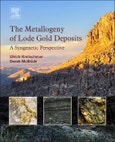The Metallogeny of Lode Gold Deposits: A Syngenetic Perspective is a synthesis of lode gold vein forming processes, addressing the commonality in similar worldwide deposits. The book's empirical model incorporates widely known and accepted principles of ore deposition and shows how it applies in the volcanic-sedimentary greenstone belt environment. Several chapters detail outcrop maps and photos of field occurrences and textures. The interpretations flow directly from the authors' field work, and are coupled with analyses of underlying physical processes. Utilizing detailed geological mapping, field work, and chemical analyses as the basis of a syngenetic formation mode, the text arms readers with the tools necessary to accurately analyze and interpret new data on the subject. This includes information on decoding the significance of asymmetry in vein formation, as well as the role of lamprophyres in gold camps, how Archean geology requires integration into a lode vein formation model, and how to develop an understanding of the worldwide applicability of gold cycles to lode vein formation and exploration and how it can be applied to deposits of all ages.
Please Note: This is an On Demand product, delivery may take up to 11 working days after payment has been received.
Table of Contents
1. Historical Perspective on Gold Formation Models 2. Interpreting Textures in Outcrop 3. Introduction to Gold Cycles 4. Field Examinations in a Variety of Gold Settings in Canada: The Meguma, Nova Scotia; Chester Twp and Beardmore, Ontario; Maskwa, Manitoba, and Nugget Pond, Newfoundland 5. Why Lamprophyres Have No Role in Lode Vein Genesis 6. Felsic Volcanism Associated with Mineralization in the Chester Complex-Type Gold Deposits 7. Understanding Hydrothermal Systems 8. The Role of Structural Geology and Remobilization# 9. Lode Gold Deposits: Their Geometry and Evidence for Seafloor Vent Systems 10. Toward a Syngenetic Model and Vent Geometry 11. Comparisons, Conclusions, Suggestions for Further Work and Application of the Syngenetic Model








